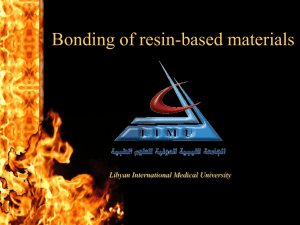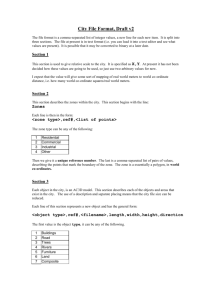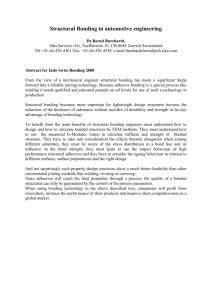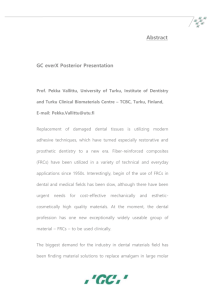cons3
advertisement
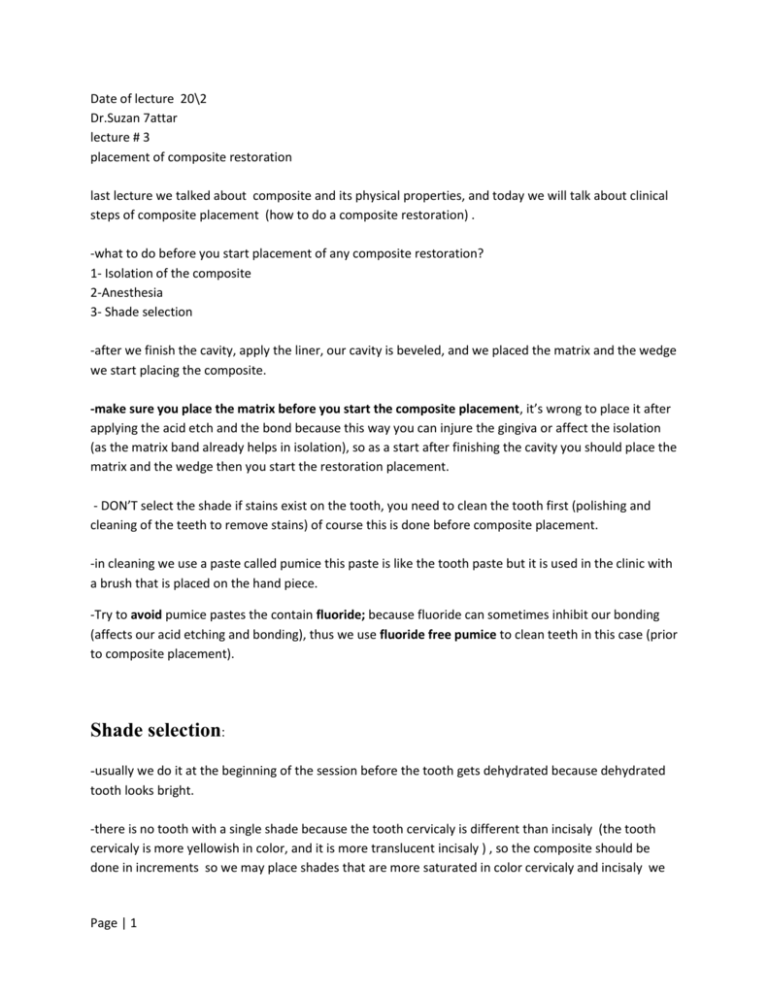
Date of lecture 20\2 Dr.Suzan 7attar lecture # 3 placement of composite restoration last lecture we talked about composite and its physical properties, and today we will talk about clinical steps of composite placement (how to do a composite restoration) . -what to do before you start placement of any composite restoration? 1- Isolation of the composite 2-Anesthesia 3- Shade selection -after we finish the cavity, apply the liner, our cavity is beveled, and we placed the matrix and the wedge we start placing the composite. -make sure you place the matrix before you start the composite placement, it’s wrong to place it after applying the acid etch and the bond because this way you can injure the gingiva or affect the isolation (as the matrix band already helps in isolation), so as a start after finishing the cavity you should place the matrix and the wedge then you start the restoration placement. - DON’T select the shade if stains exist on the tooth, you need to clean the tooth first (polishing and cleaning of the teeth to remove stains) of course this is done before composite placement. -in cleaning we use a paste called pumice this paste is like the tooth paste but it is used in the clinic with a brush that is placed on the hand piece. -Try to avoid pumice pastes the contain fluoride; because fluoride can sometimes inhibit our bonding (affects our acid etching and bonding), thus we use fluoride free pumice to clean teeth in this case (prior to composite placement). Shade selection: -usually we do it at the beginning of the session before the tooth gets dehydrated because dehydrated tooth looks bright. -there is no tooth with a single shade because the tooth cervicaly is different than incisaly (the tooth cervicaly is more yellowish in color, and it is more translucent incisaly ) , so the composite should be done in increments so we may place shades that are more saturated in color cervicaly and incisaly we Page | 1 place translucent shades . -so we never do a tooth as if single Chroma, the tooth is always multi Chromatic so the restoration should be multi chromatic. -sometimes you divide the tooth to select the shade of the composite (draw lines that divide the tooth) - Lighting may affect shade selection , for example if the light in the clinic is yellow the teeth will look yellowish in color , and the natural light that enters through the window is important in shade selection ( to be discussed later ) . - You should use the shade guide that comes with the composite kit, because shades of the composite (A1, A2,B1,B2,C1,C2……) are not the same in all the kits for example if you have two kits (X & Y) then shade (A1 )in kit X is different than shade( A1 )in kit Y . Q: if we have an old restoration and we now need to place a new restoration in the same tooth do we have to change the old one? -yes of course because you are now placing a new composite next to it. -Composite kits are providing shades that you can’t imagine; you’ll have enamel shades, dentine shades, opaque shades, and translucent shades, with all the possible colors available. - So how to do shade selection: you hold a shade guide that comes with the kit and place it next to the tooth and you take a quick look don’t look for a long period , why ? - Because if you look for a long period adaptation will occur and you will not discriminate colors in an appropriate way. So after the first 13 seconds (just like any neuro -receptors) adaptation occurs. -and after 13 seconds of looking at the shade you look at something BLUE then I look again (why blue? to be discussed later). -Sometimes you mix colors in order to get a 100% shade match because sometimes the shade colors do not match the color of the tooth 100%. -A more accurate technique in shade selection is to put a small amount of composite on the tooth and cure it to be 100% sure. Page | 2 Occlusal assessment: We talked about it in class 3, class 4, and class 5 Isolation: -rubber dam isolation: all conservative restorations should be done under rubber dam, amalgam or composite and especially composite. -CASE: if you are doing an amalgam restoration for upper 6- class 5 cavity, using cotton rolls and saliva ejector it is fine but for any composite restoration you have to use the rubber dam. ** The Dr didn’t say don’t use the rubber dam in this case but she said “it’s fine btmashi omorak”. -You also have to place the wedge and the matrix and you know why do we use the wedge (didn’t mention them) -in class 5 cavity preparation you can expose your cavity using the retraction cord, you place it in the sulcus pull it down wards a little so as to create a small space between the gingiva and the tooth plus it prevents any crevicular fluid produced by the gingiva to accumulate so you get an additional isolation. -the first generation of bonding was only enamel bonding there was no dentine bonding, but the now the new generations are enamel and dentine bonding. -Composite insertion or placement does not include condensation; so unlike amalgam you only place composite restoration in the cavity without condensing it. -amalgam restoration , you can only carve it and burnish it after 24 hours of placement and after 24 only then you can use rotary instruments to finish it , but composite once you cure it (after 40 seconds) you can use rotary instruments on it finish your composite . -All restorations except class 1 need matrices, some matrices are translucent and allow light to pass through so we can use it in the case of composite and the light to cure the composite is allowed to pass, others are metallic. Page | 3 -why do we use the matrix? 1. for isolation. 2. To determine the contour 3. For the composite : once you cure the composite and it is exposed to air the surface will be a little bit rough ,due to the presence of a layer of composite on the surface that will not be cured ,and the composite if you cure it fully and you make sure that even this layer on the surface is cured this will give you luster and polished surface that looks so beautiful so placing the matrix that is transparent and allows the light to pass and cure that layer will give you the luster you need . 4. Confine the material to the cavity. -the wedge is used to: 1. separate between the teeth 2. To compensate for the thickness of your matrix 3 .To hold the matrix in place 4. And to prevent the over hangs ; overhang: when some of the restorative material goes beyond the gingival margin. -placing the wedge: a. in the cavity is WRONG b. at the margin exactly is WRONG c. below the gingival margin is CORRECT . Placing the composite : - first we apply the acid etch : acid etching will give a rough surface and will cause demineralization to help bonding the composite to the tooth structure. -acid etching is done for both enamel and dentine but not for the same amount of time ; dentine : we apply acid etch for 15 seconds, because of the presence of dentinal tubules and the acid may cause sensitivity and dentine is less mineralized then enamel so it needs less time enamel: for 30 seconds. 1. -acid used in acid etching : phosphoric acid ,with a concentration of (39-40 %?) Page | 4 -acid etch creates micro undercuts into which the bonding agent can penetrate and once the bonding agent is polymerized it becomes interlocked with the tooth surface to provide MICROMECHANICAL RETENTION. -so composite restorative materials don’t adhere chemically but rather adhere by micromechanical retention. -micromechanical is 100 times better than macro mechanical this is why composite development depends on the fact that Micromechanically locks into the tooth. - the composite itself cannot lock into these micro pores that cannot be seen with the naked eye since the composite is a viscous material this is why we need bonding agents . -bonding agent : you remember that composite is composed of resin and filler material , the bonding agent is resin material (as if the bonding agent is an unfilled composite; contains no fillers) and chemically both are the same (the resin and the bonding agent) so they will bind chemically to each other and they become one unit vs. the tooth structure . -again there is no way for the viscous composite enters the micro pores this is why we used the bonding agent ; the bonding agent enters first then it polymerizes then we add the composite that will chemically bind to the bonding agent . -etching of enamel will affect enamel prisms and enamel core so it affects everything -acid etch transform smooth surface of enamel into a very irregular surface and increases the surface free energy. -surface free energy : -as you know when a drop of water falls on glass it remains a drop, but when a drop of water falls on blotting paper ( )النشاف ورقةit spreads this relation with the surface is called free energy ; if the surface free energy is high like in enamel after acid etching is applied then when you apply the bonding it spreads so it helps in the wettability of the surface so this is another advantage of acid etching for enamel ( bonding agent increases the surface free energy ) when surface free energy of enamel is increased then when we apply the bonding agent it will spread all over the surface instead of accumulating in a limited area . -why do we make a bevel : beveled surface includes more exposed enamel rods so applying acid etching on a beveled enamel will cause much more better bonding because the micro porosity is deeper in the case of beveled surface. Page | 5 A: Dentinal Tubule B: Inter tubular dentine C: peritubular dentin - - Dentine is composed of collagen with hydroxyapatite crystals (calcium and phosphate in certain percentages) deposited over the collagen fibers. Applying acid etching on dentine will cause demineralization, so collagen is not affected , and when minerals are no longer present between and over the collagen fibers the bonding agent will spread in areas were occupied by minerals and also inside the dentinal tubules. -so etching of dentine affects inter tubular and peritubular dentine resulting in opening of dentinal tubules leaving an interconnected network of collagen fibers. When we prepare the tooth (we use burs to remove carious lesions) a layer called smear layer is formed ; it is composed of debris formed during tooth cutting , this layer will block the dentinal tubules , acid etching of dentine will remove the smear layer and exposes dentinal tubules so that the bonding agent can go inside . - To sum up, acid etching of dentine will cause: 1. Demineralization of dentine 2. Partial or total removal of the smear layer 3. Exposure of dentinal tubules so that the bonding agent can go inside (point 3 is the end result of point 2 but the Dr mentioned them as separate points ) - When acid (while acid etching the dentine) enters the dentinal tubules the patient may develop some sensitivity but in general things will go ok but sometimes when the pulp is close or is exposed “lama el pulp ykoon hayo” we use liners to protect the pulp. Page | 6 - Demineralization of dentine reaches to 7.5 microns , this depends on : 1. The type of acids 2. Application time 3. Concentration of the acid - So not all the tubules are demineralized by the acid because the acid will penetrate to 7.5 microns only, and if it does penetrate more than 7.5 microns then this is a problem. The acid (while acid etching) will make the dentinal tubules wider. The concentration of phosphoric acid used in acid etching is between 32-37 (37 is the number to keep in mind). Using phosphoric acid( in acid etching ) with concentrations less than this range let’s say 20% Will create precipitate that will not be removed easily and then the precipitate will interfere with the adhesion. Higher concentrations of the acid will dissolve less calcium and (couldn’t hear it but I will ask the dr about it inshalla) The acid can be supplied as gel or could be supplied as liquid, if the acid was liquid then it is easier to wash it and it will penetrate more easily so it covers larger area , but it may reach areas which we don’t want it to reach . The gel formula is much easier. The phosphoric acid comes in bright colors (bright blue, bright green ,….) this way you can clearly see where are you applying the acid. Acid is applied to a maximum of 0.5 mm beyond (while preparing a central incisor for class 4 restoration you don’t apply the acid on the central, lateral, and canine ) Etching of enamel for an unprepared tooth (in the previous case let us take the canine as an example) will cause caries accumulation, bacterial accumulation, rough surface, stains, but within 24 hours due to the effect of saliva it will remineralize . We leave the acid on enamel for 15 seconds then we apply it on dentine for 15 seconds this way the acid is applied on enamel for 30 seconds and on dentine for 15 seconds After that we wash the acid for 30 seconds (because we applied it for 30 seconds) then you dry it. The tooth is now ready to receive the bonding agent. When you dry the tooth it will have a white chalky appearance, this is an indication that we applied acid etching on enamel. Keep in mind that we are talking about wet bonding, meaning that you shouldn’t over dry your tooth or else something will happen. Regarding enamel : it is ok if we over dry it till we see the white chalky appearance , but when talking about enamel and dentine together (dentine is involved) you should not over dry so this is called moist dentine or wet bonding WET BONDING keep it in mind. - - - - - Page | 7 - - - - - - - - When Collagen fibers are demineralized due to acid etching meaning that the hydroxyapatite crystals are lost , then if you over dry the collagen network will collapse, and if the collagen network collapse then it is hard for the bonding agent to enter the spaces between the fibers . Don’t worry if you over dried the tooth you can wet it again and re dry it with cotton but not with air. When collagen collapses we will have no bonding. When you apply the bonding agent you cure it (you polymerize it), then you add the composite and cure it (polymerize it) and then the two will become one unit and this unit is adhered to the tooth structure. The bonding resin will penetrate into the irregular etched enamel (irregularity and porosity in enamel due to etching) by capillary action, like the effect of the straw. when bonding resin is applied to the etched dentine it penetrates into the intertubular dentine forming a resin-dentine inter fusion zone called hybrid layer and It also penetrates in the dentinal tubules forming the resin tags; Hybrid layer(or hybrid zone) : two different materials met together , we have the dentins as separate dentine then we apply the bonding agent on dentine so we get a mixed layer in between the bonding depends on this layer formed between dentine and the bonding agent and we call this layer HYBRID LAYER . Key words: ADHESION DEPENDS ON THE HYBRID LAYER. When we etch enamel do we get a hybrid layer?? no the hybrid layer is mainly formed on dentine; because when the bonding agent is applied on dentine it doesn’t go only inside the tubules but also in between the collagen fibers and this is why we get the hybrid layer. When we etch enamel then we apply the bonding agent on enamel the bonding enters enamel by capillary action and this is a simple penetration so we don’t call it a hybrid layer but in dentine the bonding enters the meshwork of collagen and after polymerization they become one unit this is why it is important and this is why they call it hybrid layer. The part of the bonding agent that enters the dentinal tubules is called RESIN TAGS. In Previous generations of bonding agents: before you apply the bonding agent you apply acid etch then you wash it then you dry then you do the priming step (using a primer). After etching alteration in the mineral content of the dentine occurs changing its free surface energy into lower value opposite to what happened in dentine, lower value of surface free energy then the wettability is difficult so if we apply the bonding agent without priming it may not penetrate and distribute so I use primer to increase surface free energy of dentine then we apply the bonding agent. Recent generations of bonding agents contain the primer in the same kit (the tube contains both the bonding agent and the primer), so it is now one step no priming step any more,( Most modern bonding agents have the primer in the same bottle) The primers are hydrophilic monomers applies first as surface active agents (we call them surface active agents) to enhance the wettability of the hydrophobic adhesive resin. You apply the bonding agent using a cotton pellet and to make sure that the bonding agent enters the porosities created with the acid etch we use air to spread the bonding agent then we cure it for 20 seconds (it needs less time than the composite). Page | 8 - We cure the bonding agent and the composite because both contain resin and the resin is composed of monomers that should be converted to polymer and since they are both light cure Not self-cure we use the light to cure them. - If after curing the bonding agents and the tooth got contaminated with blood or saliva what do you do? It’s wrong to continue placing the restoration because the restoration will fail, so we repeat the steps starting from the etching step because acid etching removes the organic material. - For composite insertion we use plastic instruments not metallic instruments; metallic instruments change the color of composite (Aesthetic point of view) you even use a syringe to inject the composite into the cavity. Small increments are placed , when the cavity id deep like when our cavity is 4 mm deep we add 2 mm as the 1st increment and then we add another 2 mm as a 2nd increment : 1. To make sure that light penetrates and the composite is cured ( light maximum penetration is 2 mm). 2. To decrease the stresses like polymerization shrinkage. - - - - - You cure the composite 40 seconds each side; you cure the labial side 40 seconds, lingual side 40 seconds, occlusal aspect and distal aspect as well. Over curing doesn’t affect the tooth but under curing does. We hold the light source close to the tooth to be cured almost touching the tooth. The 1st increment will adhere to the 2nd increment by the action of air inhibited layer. Contouring composite: composite is unlike amalgam in that you can’t carve the composite ; but rather you place it, cure it, finishing them using burs (high speed with water usually diamond finishing burs or carbide finishing bur ). Diamond finishing bur : it is a finishing bur so the diamond present on the bur is very small so we call it fine grid diamond bur, and the color of the bur is either white or yellow (depending on the size of diamond present on the bur). Flame shaped bur is used for beveled surfaces. Disc shaped bur is not used on the occlusal surfaces because it will make the surface flat, but we can use it on the labial surface. You have to finish your composite starting with diamond burs and then you can use stones like white stone then we can use discs or (?) ** **I will ask about this point You can also add polishing as a step if you wish. Check the occlusion. NOURA ODEH Page | 9 Page | 10


